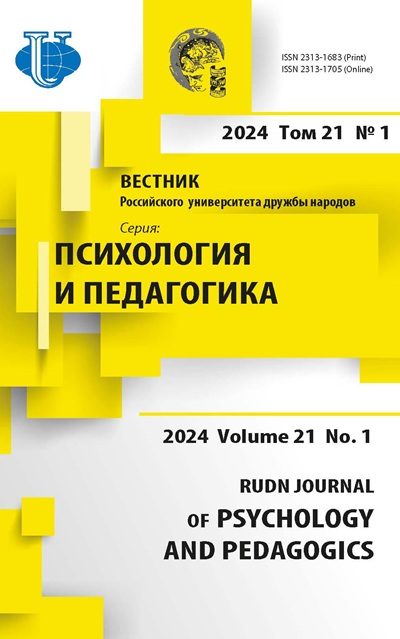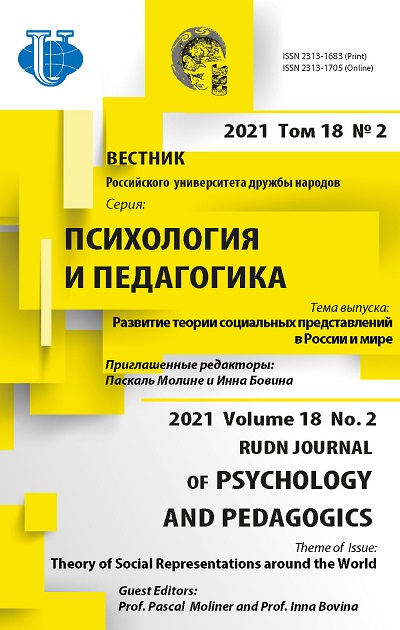Social Representations of the Coronavirus at the Beginning of the Pandemic in Russia
- Authors: Dontsov A.I.1, Zotova O.Y.2, Tarasova L.V.2
-
Affiliations:
- Lomonosov Moscow State University
- Liberal Arts University - University for Humanities
- Issue: Vol 18, No 2 (2021): Theory of Social Representations around the World
- Pages: 422-444
- Section: IMAGES AND MEDIA
- URL: https://journals.rudn.ru/psychology-pedagogics/article/view/26913
- DOI: https://doi.org/10.22363/2313-1683-2021-18-2-422-444
Cite item
Full Text
Abstract
The coronavirus outbreak is a global event that has bypassed national borders and affected the entire world. Therefore, examining social representations of can reveal the problems that structure people’s experiences in a particular social context. To identify social representations of the coronavirus, the authors conducted a survey within the territory of the Sverdlovsk region. The survey covered the period from March 11 to May 11, 2020. The data were collected in two stages: at the first stage, there were 31 confirmed cases of COVID-19 infection in Russia, but no cases had yet been recorded in the Sverdlovsk region; at the second stage, the number of cases reached 1952 in the Sverdlovsk region and 221 344 throughout the country. The study used the word association tests, The Semantic Differential Scale (V.F. Petrenko), The Psychic Activation Assessment Methodology (L.A. Kurgan and T.A. Nemchin) and the questionnaire survey techniques. The findings showed that the significance of the coronavirus problem for the respondents varied in different periods of the pandemic. The core of the social representation is sustainable and coherent. It reflects the results of the media impact: death, panic. It also remains stable regardless of the time and involvement of the respondents in the pandemic. The potential alteration zone serves as a kind of ‘taming’ of knowledge about the coronavirus, the operationalization of the coronavirus perception content into the language of changes in a person’s everyday life - the coronavirus pandemic is understood as a ‘flu epidemic’ and the need for self-isolation is a ‘vacation’, an opportunity ‘to stay at home’. Observation of the immediate affective reaction of the respondents to the trigger ‘coronavirus’ uncovered the presence of emotional tension and the prevalence of negative experiences in them. The survey also showed that in the pandemic, being the main source of information and a means of communication, the media set trends for developing perceptions.
About the authors
Aleksandr I. Dontsov
Lomonosov Moscow State University
Author for correspondence.
Email: a.dontsov@mail.ru
ORCID iD: 0000-0001-7432-3572
D.Sc. in Psychology, Full Professor, is Professor at Social Psychology Department
11 Mokhovaya St, bldg 9, Moscow, 125009, Russian FederationOlga Yu. Zotova
Liberal Arts University - University for Humanities
Email: oiambusheva@mail.ru
ORCID iD: 0000-0002-5607-6317
D.Sc. in Psychology, Associate Professor, is Professor at Social Psychology Department
24А Surikov St, Yekaterinburg, 620144, Russian FederationLyudmila V. Tarasova
Liberal Arts University - University for Humanities
Email: tarasovagu@mail.ru
ORCID iD: 0000-0003-3390-0454
Ph.D. in Psychology, Associate Professor, is Associate Professor at General and Applied Psychology Department
24А Surikov St, Yekaterinburg, 620144, Russian FederationReferences
- APA. (2020). Stress in America. Retrieved February 20, 2021, from https://www.apa.org/news/press/releases/stress/2020/report
- Apostolidis, T., Fatima Santos, M. de, & Kalampalikis, N. (2020). Society Against Covid-19: Challenges for the Socio-genetic Point of View of Social Representations. Papers on Social Representations, 29(2): Special issue: Social Representations of Covid-19: Rethinking the Pandemic’s Reality and Social Representations, 3.1–3.14.
- Barry, J.M. (2004). The Great Influenza: The Story of the Deadliest Pandemic in History. New York: Viking Press.
- Bish, A., & Michie, S. (2010). Demographic and Attitudinal Determinants of Protective Behaviours during a Pandemic: A Review. British Journal of Health Psychology, 15(4), 797–824. https://doi.org/10.1348/135910710X485826
- Brewer, N.T., Weinstein, N.D., Cuite, C.L., & Herrington, J.E. (2004). Risk perceptions and their relation to risk behavior. Annals of Behavioral Medicine, 27(2), 125–130. https://doi.org/10.1207/s15324796abm2702_7
- Colì, E., Norcia, M., & Bruzzone, A. (2020). What Do Italians Think About Coronavirus? An Exploratory Study on Social Representations. Papers on Social Representations, 29(2): Special issue: Social Representations of Covid-19: Rethinking the Pandemic’s Reality and Social Representations, 7.1–7.29.
- Zwart, O. de, Veldhuijzen, I.K., Elam, G., Aro, A.R., Abraham, T., Bishop, G.D. …, & Brug, J. (2009). Perceived Threat, Risk Perception, and Efficacy Beliefs Related to SARS and Other (Emerging) Infectious Diseases: Results of an International Survey. International Journal of Behavioral Medicine, 16(1), 30–40. http://doi.org/10.1007/s12529-008-9008-2
- Zwart, O. de, Veldhuijzen, I.K., Elam, G., Aro, A.R., Abraham, T., Bishop, G.D. …, & Brug, J. (2007). Avian Influenza Risk Perception, Europe and Asia. Emerging Infectious Diseases, 13(2), 290–293. http://doi.org/10.3201/eid1302.060303
- Dryhurst, S., Schneider, C.R., Kerr, J., Freeman, A.L.J., Recchia, G., Bles van der, A.M. …, & Linden, S. van der. (2020). Risk perceptions of COVID-19 around the world. Journal of Risk Research, 23(7–8), 994–1006. https://doi.org/10.1080/13669877.2020.1758193
- Emeliyanova, T.P. (2001). The Social Representation – the Meaning and Concept: The Findings of the Past Decade. Psikhologicheskii Zhurnal, 22(6), 39–47. (In Russ.)
- Emiliani, F., Contarello, A., Brondi, S., Palareti, L., Passini, S., & Romaioli, D. (2020). Social Representations of “Normality”: Everyday Life in Old and New Normalities with Covid-19. Papers on Social Representations, 29(2): Special issue: Social Representations of Covid-19: Rethinking the Pandemic’s Reality and Social Representations, 9.1–9.36.
- Fasanelli, R., Piscitelli, A., & Galli, I. (2020). Social Representations of Covid-19 in the Framework of Risk Psychology. Papers on Social Representations, 29(2): Special issue: Social Representations of Covid-19: Rethinking the Pandemic’s Reality and Social Representations, 8.1–8.36.
- Fischhoff, B., Wong-Parodi, G., Garfin, D.R., Holman, E.A., & Silver, R.C. (2018). Public Understanding of Ebola Risks: Mastering an Unfamiliar Threat. Risk Analysis, 38(1), 71–83. http://doi.org/10.1111/risa.12794
- Försterling, F. (2001). Attribution: An introduction to theories, research and applications. Hove: Psychology Press.
- Hewstone, M. (1989). Causal attribution: From cognitive processes to collective beliefs. Oxford: Basil Blackwell.
- Hogenraad, R. (2017). Smoke and mirrors: Tracing ambiguity in texts. Digital Scholarship in the Humanities, 33(2), 297–315. https://doi.org/10.1093/llc/fqx044
- Howarth, C. (2002). Identity in whose eyes?: The role of representations in identity construction. Journal for the Theory of Social Behaviour, 32(2), 145–162. https://doi.org/10.1111/1468-5914.00181
- Joffe, H. (1999). Risk and “the other”. Cambridge: University Press.
- Joffe, H., Washer, P., & Solberg, C. (2011). Public engagement with emerging infectious disease: The case of MRSA in Britain. Psychology & Health, 21(6), 667–683. https://doi.org/10.1080/08870441003763238
- Jovchelovitch, S. (2008). The rehabilitation of common sense: Social representations, science and cognitive polyphasia. Journal for the Theory of Social Behaviour, 38(4), 431–448. https://doi.org/10.1111/j.1468-5914.2008.00378.x
- Justo, A.M., Silva Bousfield, A.B. da, Giacomozzi, A.I., & Camargo, B.V. (2020). Communication, Social Representations and Prevention – Information Polarization on COVID-19 in Brazil. Papers on Social Representations, 29(2): Special issue: Social Representations of Covid-19: Rethinking the Pandemic’s Reality and Social Representations, 4.1–4.18.
- Kalyukov, E. (2020, January 31). V Rossii vyyavili pervykh zarazhennykh koronavirusom iz Kitaya. RBC. (In Russ.) Retrieved February 20, 2021, from https://www.rbc.ru/society/31/01/2020/5e341f929a7947d43c9aa308
- Leiserowitz, A. (2006). Climate Change Risk Perception and Policy Preferences: The Role of Affect, Imagery, and Values. Climatic Change, 77(1–2), 45–72. https://doi.org/10.1007/s10584-006-9059-9
- Moliner, P., & Bovina, I. (2019). Architectural Forms of Collective Memory. International Review of Social Psychology, 32(1), 12. http://doi.org/10.5334/irsp.236
- Moscovici, S. (1988). Notes towards a description of social representations. European Journal of Social Psychology, 18(3), 211–250. https://doi.org/10.1002/ejsp.2420180303
- Musil, R. (1990). Precision and Soul: Essays and Addresses. Chicago: University of Chicago Press.
- Office of the Federal Service for the Protection of Consumer’ Rights and Human Wellbeing in the Sverdlovsk region. (2020, June 16). Informatsionnyi byulleten' po zabolevaemosti novoi koronavirusnoi infektsiei v Sverdlovskoi oblasti na 16.06.2020 g. (In Russ.) Retrieved February 20, 2021, from http://www.66.rospotrebnadzor.ru/
- Pizarro, J.J., Cakal, H., Méndez-Casas, L., Costa da, S., Zumeta, L., Gracia-Leiva, M. ..., & Cavalli, S. (2020). Tell me what you are like and I will tell you what you believe in: Social representations of COVID-19 in the Americas, Europe and Asia. Papers on Social Representations, 29(2): Special issue: Social Representations of Covid-19: Rethinking the Pandemic’s Reality and Social Representations, 2.1–2.38.
- Poletti, P., Ajelli, M., & Merler, S. (2011). The Effect of Risk Perception on the 2009 H1N1 Pandemic Influenza Dynamics. PLoS One, 6(2), e16460. https://doi.org/10.1371/journal.pone.0016460
- Prati, G., & Pietrantoni, L. (2016). Knowledge, Risk Perceptions, and Xenophobic Attitudes: Evidence from Italy during the Ebola Outbreak. Risk Analysis, 36(10), 2000–2010. https://doi.org/10.1111/risa.12537
- Prati, G., Pietrantoni, L., & Zani, B. (2011). A Social-Cognitive Model of Pandemic Influenza H1N1 Risk Perception and Recommended Behaviors in Italy. Risk Analysis, 31(4), 645–656. https://doi.org/10.1111/j.1539-6924.2010.01529.x
- Prentice, T., & Reinders L. T. (2007). A More Secure Future: Global Public Health Security in the 21st century: Report on the State of the World Public Health Care. Geneva: WHO. (In Russ.)
- Pronina, E.E. (2002). Psikhologicheskaya ekspertiza reklamy: Teoriya i metodika psikhotekh-nicheskogo analiza reklamy. Moscow: RIP-holding, 2002. (In Russ.)
- Reluga, T.C. (2010). Game Theory of Social Distancing in Response to an Epidemic. PLoS Computational Biology, 6(5), e1000793. https://doi.org/10.1371/journal.pcbi.1000793
- Rudisill, C. (2013). How Do we Handle New Health Risks? Risk Perception, Optimism, and Behaviors regarding the H1N1 Virus. Journal of Risk Research, 16(8), 959–980. https://doi.org/10.1080/13669877.2012.761271
- Sitto, K., & Lubinga, E. (2020). A Disease of Privilege? Social Representations in Online Media about Covid-19 among South Africans during Lockdown. Papers on Social Representations, 29(2): Special issue: Social Representations of Covid-19: Rethinking the Pandemic’s Reality and Social Representations, 6.1–6.29.
- Slovic, P. (1992). Perception of Risk: Reflections on the Psychometric Paradigm. In D. Goldingand & S. Krimsky (Eds.), Theories of Risk (pp. 117–152). New York: Praeger.
- Slovic, P. (2010). The Feeling of Risk: New Perspectives on Risk Perception. New York: Routledge.
- Sotsium. (2020, May). Otnoshenie naseleniya Ekaterinburga k situatsii samoizolyatsii i planam vykhoda iz nee. (In Russ.) Retrieved February 20, 2021, from https://fsocium.com/coronacrysis-plans/
- Thilliez, F. (2016). Pandemiya. Moscow: Azbuka-Attikus Publ. (In Russ.)
- Trope, Y., & Liberman, N. (2010). Construal Theory. Psychological Review, 117(2), 440–463. https://doi.org/10.1037/a0018963
- Bavel, J.J. van, Baicker, K., Boggio, P., Capraro, V., Cichocka, A., Cikara, M. …, & Willer, R. (2020). Using Social and Behavioural Science to Support COVID-19 Pandemic Response. Nature Human Behaviour, 4, 460–471. https://doi.org/10.1038/s41562-020-0884-z
- Linden, S. van der. (2015). The Social-Psychological Determinants of Climate Change Risk Perceptions: Towards a Comprehensive Model. Journal of Environmental Psychology, 41, 112–124. https://doi.org/10.1016/j.jenvp.2014.11.012
- Linden, S. van der. (2017). Determinants and Measurement of Climate Change Risk Perception, Worry, and Concern. In M.C. Nisbet, M. Schafer, E. Markowitz, S. Ho, S. O'Neill, J. Thaker (Eds.), Oxford Research Encyclopedia of Climate Science (pp. 1–49). Oxford: Oxford University Press. http://dx.doi.org/10.2139/ssrn.2953631
- Vergès, P. (1992). L’Evocation de l’argent: Uneméthode pour la définition du noyau central d’une representation. Bulletin de Psychologie, 45(405), 203–209. (In French.)
- WHO. (2020, March 30). WHO Director-General's opening remarks at the media briefing on COVID-19. Retrieved February 20, 2021, from https://www.who.int/dg/speeches/detail/who-director-general-s-opening-remarks-at-the-media-briefing-on-covid-19---11-march-2020
- Witte, K., Meyer, G., & Martell, D. (2001). Effective Health Risk Messages: A Step-by-Step Guide. Thousand Oaks: Sage.
- Yang, J.Z., & Chu, H. (2018). Who is Afraid of the Ebola Outbreak? The Influence of Discrete Emotions on Risk Perception. Journal of Risk Research, 21(7), 834–853. https://doi.org/10.1080/13669877.2016.1247378
- Zinchenko, Yu.P., & Zotova, O.Yu. (2014). Security in the worldview of Russians. Psychology in Russia: State of the Art, 7(1), 50–61. https://doi.org/10.11621/pir.2014.0106
















